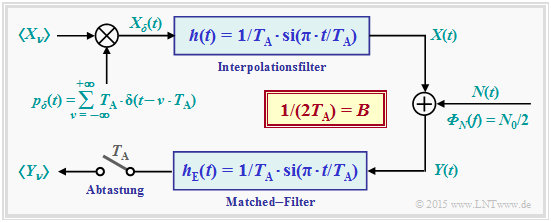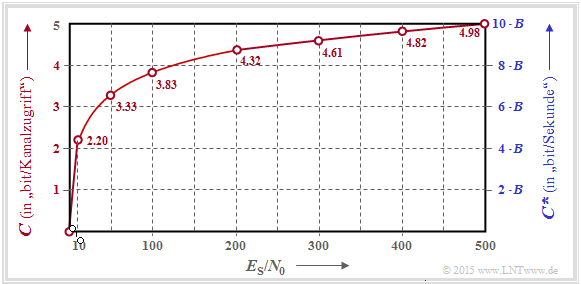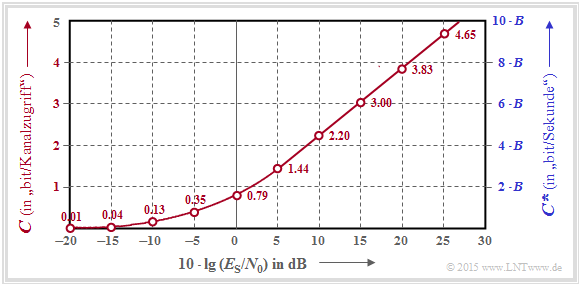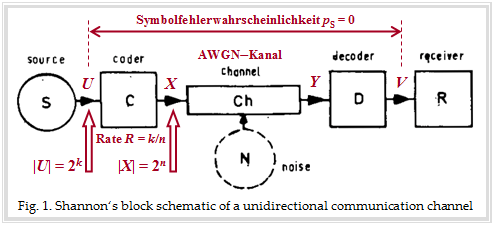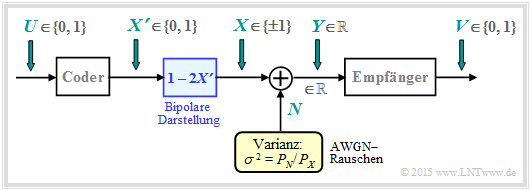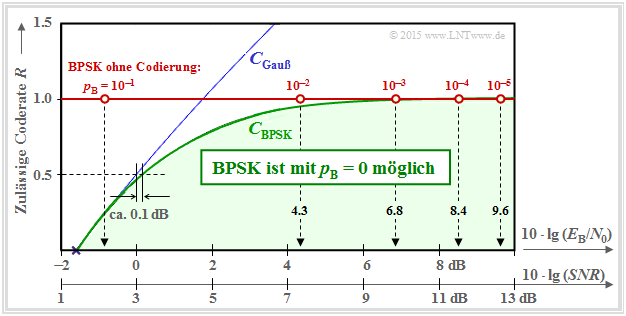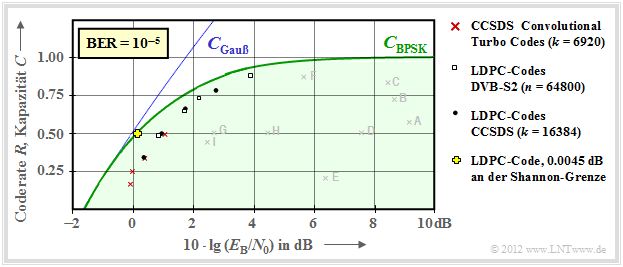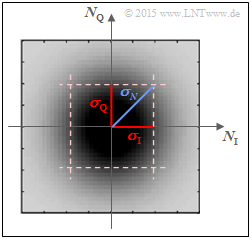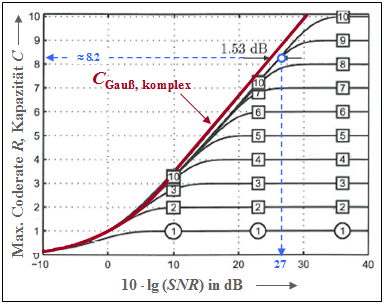Contents
- 1 AWGN model for discrete-time band-limited signals
- 2 The channel capacity $C$ as a function of $E_{\rm S}/N_0$
- 3 System model for the interpretation of the AWGN channel capacity
- 4 The channel capacity $C$ as a function of $E_{\rm B}/N_0$
- 5 AWGN channel capacity for binary input signals
- 6 Comparison between theory and practice
- 7 Channel capacity of the complex AWGN channel
- 8 Maximum code rate for QAM structures
- 9 Relevant tasks
- 10 Sources
AWGN model for discrete-time band-limited signals
At the end of the last chapter , the AWGN model was used according to the left graph, characterised by the two random variables $X$ and $Y$ at the input and output and the stochastic noise $N$ as the result of a mean-free Gaussian random process ⇒ „White noise” with variance $σ_N^2$. The interference power $P_N$ is also equal toh $σ_N^2$.
The maximum mutual information $I(X; Y)$ between input and output ⇒ channel capacity $C$ is obtained when there is a Gaussian input PDF $f_X(x)$ vorliegt. With the transmit power $P_X = σ_X^2$ ⇒ variance of the random variable $X$ , the channel capacity equation is:
- $$C = 1/2 \cdot {\rm log}_2 \hspace{0.1cm} ( 1 + {P_X}/{P_N}) \hspace{0.05cm}.$$
Now we describe the AWGN channel model according to the case sketched on the right, where the sequence $〈X_ν〉$ is applied to the channel input, where the distance between successive values is $T_{\rm A}$ . This sequence is the discrete-time equivalent of the continuous-time signal $X(t)$ after band limiting and sampling.
The relationship between the two models can be established by means of a graph, which is described in more detail below.
The $\text{important insights}$ :
- In the right-hand model, the same relationship $Y_ν = X_ν + N_ν$ applies at the sampling times $ν·T_{\rm A}$ as in the left-hand model.
- The noise component $N_ν$ is now to be modelled by band-limited $($auf $±B)$ white noise with the two-sided power density ${\it Φ}_N(f) = N_0/2$ , where $B = 1/(2T_{\rm A})$ must hold ⇒ see sampling theorem.
$\text{ Interpretation:}$
In the modified model, we assume an infinite sequence $〈X_ν〉$ of Gaussian random variables impressed on a Diracpuls $p_δ(t)$ . The resulting discrete-time signal is thus:
- $$X_{\delta}(t) = T_{\rm A} \cdot \hspace{-0.1cm} \sum_{\nu = - \infty }^{+\infty} X_{\nu} \cdot \delta(t- \nu \cdot T_{\rm A} )\hspace{0.05cm}.$$
The spacing of all (weighted) Dirac functions is uniform $T_{\rm A}$.
Through the interpolation filter with the impulse response $h(t)$ as well as the frequency response $H(f)$, where
- $$h(t) = 1/T_{\rm A} \cdot {\rm si}(\pi \cdot t/T_{\rm A}) \quad \circ\!\!\!-\!\!\!-\!\!\!-\!\!\bullet \quad H(f) = \left\{ \begin{array}{c} 1 \\ 0 \\ \end{array} \right. \begin{array}{*{20}c} {\rm{f\ddot{u}r}} \hspace{0.3cm} |f| \le B, \\ {\rm{f\ddot{u}r}} \hspace{0.3cm} |f| > B, \\ \end{array} \hspace{0.5cm} B = \frac{1}{T_{\rm A}}$$
must hold, the continuous-time signal $X(t)$ is obtained with the following properties:
- The samples $X(ν·T_{\rm A})$ are identical to the input values $X_ν$ for all integers $ν$ , which can be justified by the equidistant zeros of the sinc - function ⇒ $\text{si}(x) = \sin(x)/x$ .
- According to the sampling theorem, $X(t)$ is ideally bandlimited to the spectral range $±B$ , as the above calculation has shown ⇒ rectangular frequency response $H(f)$ of the one-sided bandwidth $B$.
$\text{Noise power:}$ After adding the noise $N(t)$ with the (two-sided) power density ${\it Φ}_N(t) = N_0/2$ , the matched filter $\rm (MF)$ with sinc–shaped impulse response follows. The following then applies to the noise power at the MF output :
- $$P_N = {\rm E}\big[N_\nu^2 \big] = \frac{N_0}{2T_{\rm A} } = N_0 \cdot B\hspace{0.05cm}.$$
$\text{Proof:}$ With $B = 1/(2T_{\rm A} )$ one obtains for the impulse response $h_{\rm E}(t)$ and the spectral function $H_{\rm E}(f)$:
- $$h_{\rm E}(t) = 2B \cdot {\rm si}(2\pi \cdot B \cdot t) \quad \circ\!\!\!-\!\!\!-\!\!\!-\!\!\bullet \quad H_{\rm E}(f) = \left\{ \begin{array}{c} 1 \\ 0 \\ \end{array} \right. \begin{array}{*{20}c} \text{für} \hspace{0.3cm} \vert f \vert \le B, \\ \text{für} \hspace{0.3cm} \vert f \vert > B. \\ \end{array} $$
It follows, according to the insights of theory of stochastic signals:
- $$P_N = \int_{-\infty}^{+\infty} \hspace{-0.3cm} {\it \Phi}_N (f) \cdot \vert H_{\rm E}(f)\vert^2 \hspace{0.15cm}{\rm d}f = \int_{-B}^{+B} \hspace{-0.3cm} {\it \Phi}_N (f) \hspace{0.15cm}{\rm d}f = \frac{N_0}{2} \cdot 2B = N_0 \cdot B \hspace{0.05cm}.$$
Further:
- If one samples the matched–filter output signal at equidistant intervals $T_{\rm A}$ , the same constellation as before results for the time instants $ν ·T_{\rm A}$ , namely: $Y_ν = X_ν + N_ν$.
- The noise component $N_ν$ in the discrete-time output signal $Y_ν$ is thus „band limited” and „white”. The channel capacity equation thus needs to be adjusted only slightly.
- With $\text{energy per symbol}$ $E_{\rm S} = P_X \cdot T_{\rm A}$ ⇒ transmission energy within a "symbol duration" $T_{\rm A}$ then holds:
- $$C = {1}/{2} \cdot {\rm log}_2 \hspace{0.1cm} ( 1 + \frac {P_X}{N_0 \cdot B}) = {1}/{2} \cdot {\rm log}_2 \hspace{0.1cm} ( 1 + \frac {2 \cdot P_X \cdot T_{\rm A}}{N_0}) = {1}/{2} \cdot {\rm log}_2 \hspace{0.1cm} ( 1 + \frac {2 \cdot E_{\rm S}}{N_0}) \hspace{0.05cm}.$$
The channel capacity $C$ as a function of $E_{\rm S}/N_0$
$\text{Example 1:}$ The graph shows the variation of the AWGN channel capacity as a function of the quotient $E_{\rm S}/N_0$, where the left coordinate axis and the red labels are valid:
- $$C = {1}/{2} \cdot {\rm log}_2 \hspace{0.1cm} ( 1 + \frac { 2 \cdot E_{\rm S} }{N_0}) \hspace{0.5cm}{\rm Einheit\hspace{-0.15cm}: \hspace{0.05cm}bit/Kanalzugriff\hspace{0.15cm} (englisch\hspace{-0.15cm}: \hspace{0.05cm}bit/channel\hspace{0.15cm}use)} \hspace{0.05cm}.$$
The (pseudo–)unit is sometimes also referred to as „bit/source symbol” or „bit/symbol” for short.
The right (blue) axis label takes into account the relation $B = 1/(2T_{\rm A})$ and thus provides an upper bound for the bit rate $R$ a digital system that is still possible for this AWGN channel.
- $$C^{\hspace{0.05cm}*} = \frac{C}{T_{\rm A} } = B \cdot {\rm log}_2 \hspace{0.1cm} ( 1 + \frac { 2 \cdot E_{\rm S} }{N_0}) \hspace{1.0cm}{\rm Einheit\hspace{-0.15cm}: \hspace{0.05cm}bit/second} \hspace{0.05cm}.$$
$\text{Example 2:}$ Often one gives the quotient of symbol energy $(E_{\rm S})$ and AWGN noise power density $(N_0)$ logarithmically.
- This graph shows the channel capacities $C$ and $C^{\hspace{0.05cm}*}$ respectively as a function of $10 · \lg (E_{\rm S}/N_0)$ in the range from $-20 \ \rm dB$ to $+30 \ \rm dB$.
- From about $10 \ \rm dB$ onwards, a (nearly) linear curve results here.
System model for the interpretation of the AWGN channel capacity
In order to discuss the channel coding theorem in the context of the AWGN channel, we still need an "encoder", but here it is characterized in information-theoretic terms by the code rate $R$ alone.
The graphic describes the message system considered by Shannon with the blocks source, coder, (AWGN) channel, decoder and receiver. In the background you can see an original picture from a paper about the Shannon theory. We have drawn in red some designations and explanations for the following text:
- The source symbol $U$ comes from an alphabet with $M_U = |U| = 2^k$ symbols and can be represented by $k$ equally probable statistically independent binary symbols.
- The alphabet of the code symbol $X$ has the symbol set size $M_X = |X| = 2^n$, where $n$ results from the code rate $R = k/n$ .
- Thus, for code rate $R = 1$ , $n = k$ and the case $n > k$ leads to code rate $R < 1$.
$\rm Channel coding theorem$
This states that there is (at least) one code of rate $R$ that leads to symbol error probability $p_{\rm S} = \text{Pr}(V ≠ U) \equiv 0$ if the following conditions are satisfied:
- The code rate $R$ is not larger than the channel capacity $C$.
- Such a suitable code is infinitely long: $n → ∞$. Therefore, a Gaussian distribution $f_X(x)$ at the channel input is indeed possible, which has always been the basis of the previous calculation of the AWGN channel capacity:
- $$C = {1}/{2} \cdot {\rm log}_2 \hspace{0.1cm} ( 1 + \frac { 2 \cdot E_{\rm S} }{N_0}) \hspace{0.5cm}{\rm Einheit\hspace{-0.15cm}: \hspace{0.05cm}bit/channel use\hspace{0.15cm} } \hspace{0.05cm}.$$
- Thus, the channel input quantity $X$ is continuous in value. The same is true for $U$ and for the quantities $Y$, $V$ after the AWGN channel.
- For a system comparison, however, the energy per symbol $(E_{\rm S} )$ is unsuitable. A comparison should rather be based on the energy $E_{\rm B}$ per information bit ⇒ $\text{Energie pro Bit}$ for short. Thus, with $E_{\rm B} = E_{\rm S}/R$ also holds:
- $$C = {1}/{2} \cdot {\rm log}_2 \hspace{0.1cm} ( 1 + \frac { 2 \cdot R \cdot E_{\rm B} }{N_0}) \hspace{0.2cm}{\rm Einheit\hspace{-0.15cm}: \hspace{0.05cm}bit/Kanalzugriff\hspace{0.1cm} (englisch\hspace{-0.15cm}: \hspace{0.05cm}bit/channel \hspace{0.15cm}use)} \hspace{0.05cm}.$$
These two equations are discussed on the next page.
The channel capacity $C$ as a function of $E_{\rm B}/N_0$
$\text{Example 3:}$ The graph for this example shows the AWGN channel capacity $C$ as a function
- of $10 · \lg (E_{\rm S}/N_0)$ ⇒ red curve:
- $$C = {1}/{2} \cdot {\rm log}_2 \hspace{0.1cm} ( 1 + \frac { 2 \cdot E_{\rm S} }{N_0}) \hspace{1.5cm}{\rm unit\hspace{-0.15cm}: \hspace{0.05cm}bit/channel use\hspace{0.15cm} (oder\hspace{-0.15cm}: \hspace{0.05cm}bit/Symbol)} \hspace{0.05cm}.$$
$\text{Red numbers:}$ Capacity $C$ in „$\rm bit/symbol$” for $10 · \lg (E_{\rm S}/N_0) = -20 \ \rm dB, -15 \ \rm dB$, ... , $+30\ \rm dB$.
- von $10 · \lg (E_{\rm B}/N_0)$ ⇒ green curve:
- $$C = {1}/{2} \cdot {\rm log}_2 \hspace{0.1cm} ( 1 + \frac { 2 \cdot R \cdot E_{\rm B} }{N_0}) \hspace{1.2cm}{\rm unit\hspace{-0.15cm}: \hspace{0.05cm}bit/channel use\hspace{0.1cm} (oder \hspace{-0.15cm}: \hspace{0.05cm}bit/Symbol)} \hspace{0.05cm}.$$
$\text{Green numbers:}$ Required $10 · \lg (E_{\rm B}/N_0)$ in „$\rm dB$” for $C = 0,\ 1$, ... , $5$ in „$\rm bit/symbol$”.
The detailed $C(E_{\rm B}/N_0)$ calculation can be found in rask 4.8 and the corresponding sample solution.
In the following, we interpret the (green) $C(E_{\rm B}/N_0)$ result in comparison to the (red) $C(E_{\rm S}/N_0)$ curve:
- Because of $E_{\rm S} = R · E_{\rm B}$ , the intersection of both curves is at $C (= R) = 1$ (bit/symbol). Required are $10 · \lg (E_{\rm S}/N_0) = 1.76\ \rm dB$ or $10 · \lg (E_{\rm B}/N_0) = 1.76\ \rm dB$ equally.
- In the range $C > 1$ the green curve always lies above the red curve. For example, for $10 · \lg (E_{\rm B}/N_0) = 20\ \rm dB$ the channel capacity is $C ≈ 5$, for $10 · \lg (E_{\rm S}/N_0) = 20\ \rm dB$ only $C = 3.83$.
- A comparison in horizontal direction shows that the channel capacity $C = 3$ bit/symbol is already achievable with $10 · \lg (E_{\rm B}/N_0) \approx 10\ \rm dB$ , but one needs $10 · \lg (E_{\rm S}/N_0) \approx 15\ \rm dB$ benötigt.
- In the range $C < 1$ , the red curve is always above the green one. For any $E_{\rm S}/N_0 > 0$ , $C > 0$. Thus, for logarithmic abscissa as in the present plot, the red curve extends to „minus infinity”.
- In contrast, the green curve ends at $E_{\rm B}/N_0 = \ln (2) = 0.693$ ⇒ $10 · \lg (E_{\rm B}/N_0)= -1.59 \rm dB$ ⇒ absolute limit for (error-free) transmission over the AWGN channel.
AWGN channel capacity for binary input signals
On the previous pages of this chapter we always assumed a Gaussian distributed, i.e. value continuous AWGN input $X$ according to Shannon theory. Now we consider the binary case and thus only now do justice to the title of the chapter „AWGN channel capacity with discrete value input” .
The diagram shows the underlying block diagram for Binary Phase Shift Keying (BPSK) with binary input $U$ and binary output $V$. The best possible coding is to achieve that the error probability $\text{Pr}(V ≠ U)$ becomes vanishingly small.
- The coder output is characterized by the binary random variable $X \hspace{0.03cm}' = \{0, 1\}$ ⇒ $M_{X'} = 2$, while the output $Y$ of the AWGN channel remains continuous-valued: $M_Y → ∞$.
- Mapping $X = 1 - 2X\hspace{0.03cm} '$ takes us from the unipolar representation to the bipolar (antipodal) description more suitable for BPSK: $X\hspace{0.03cm} ' = 0 → \ X = +1; \hspace{0.5cm} X\hspace{0.03cm} ' = 1 → X = -1$.
- The AWGN channel is characterised by two conditional probability density functions:
- $$f_{Y\hspace{0.05cm}|\hspace{0.03cm}{X}}(y\hspace{0.05cm}|\hspace{0.03cm}{X}=+1) =\frac{1}{\sqrt{2\pi\sigma^2}} \cdot {\rm exp}\left [-\frac{(y - 1)^2} { 2 \sigma^2})\right ] \hspace{0.05cm}\hspace{0.05cm},\hspace{0.5cm}\text{Kurzform:} \ \ f_{Y\hspace{0.05cm}|\hspace{0.03cm}{X}}(y\hspace{0.05cm}|\hspace{0.03cm}+1)\hspace{0.05cm},$$
- $$f_{Y\hspace{0.05cm}|\hspace{0.03cm}{X}}(y\hspace{0.05cm}|\hspace{0.03cm}{X}=-1) =\frac{1}{\sqrt{2\pi\sigma^2}} \cdot {\rm exp}\left [-\frac{(y + 1)^2} { 2 \sigma^2})\right ] \hspace{0.05cm}\hspace{0.05cm},\hspace{0.5cm}\text{Kurzform:} \ \ f_{Y\hspace{0.05cm}|\hspace{0.03cm}{X}}(y\hspace{0.05cm}|\hspace{0.03cm}-1)\hspace{0.05cm}.$$
- Since here the signal $X$ is normalised to $±1$ ⇒ power $1$ instead of $P_X$, the variance of the AWGN noise $N$ must be normalised in the same way: $σ^2 = P_N/P_X$.
- The receiver makes a maximum likelihood decision from the real-valued random variable $Y$ (at the AWGN channel output). The receiver output $V$ is binary $(0$ or $1)$.
Based on this model, we now calculate the channel capacity of the AWGN channel.
For a binary input variable $X$ , this is generally $\text{Pr}(X = -1) = 1 - \text{Pr}(X = +1)$:
- $$C_{\rm BPSK} = \max_{ {\rm Pr}({X} =+1)} \hspace{-0.15cm} I(X;Y) \hspace{0.05cm}.$$
Due to the symmetrical channel, it is obvious that the input probabilities are
- $${\rm Pr}(X =+1) = {\rm Pr}(X =-1) = 0.5 $$
will lead to the optimum. According to the page calculation of mutual information with additive noise , there are several calculation possibilities:
- $$ \begin{align*}C_{\rm BPSK} & = h(X) + h(Y) - h(XY)\hspace{0.05cm},\\ C_{\rm BPSK} & = h(Y) - h(Y|X)\hspace{0.05cm},\\ C_{\rm BPSK} & = h(X) - h(X|Y)\hspace{0.05cm}. \end{align*}$$
AAll results still have to be supplemented by the pseudo-unit „bit/channel use” zu ergänzen. We choose the middle equation here:
- The conditional differential entropy required for this is equal to
- $$h(Y\hspace{0.03cm}|\hspace{0.03cm}X) = h(N) = 1/2 \cdot {\rm log}_2 \hspace{0.1cm}(2\pi{\rm e}\cdot \sigma^2) \hspace{0.05cm}. $$
- The differential entropy $h(Y)$ is completely given by the PDF $f_Y(y)$ gegeben. Using the conditional probability density functions defined and sketched in the front, we obtain:
- $$f_Y(y) = {1}/{2} \cdot \big [ f_{Y\hspace{0.03cm}|\hspace{0.03cm}{X}}(y\hspace{0.05cm}|\hspace{0.05cm}{X}=-1) + f_{Y\hspace{0.03cm}|\hspace{0.03cm}{X}}(y\hspace{0.05cm}|\hspace{0.05cm}{X}=+1) \big ]\hspace{0.3cm} \Rightarrow \hspace{0.3cm} h(Y) \hspace{-0.01cm}=\hspace{0.05cm} -\hspace{-0.7cm} \int\limits_{y \hspace{0.05cm}\in \hspace{0.05cm}{\rm supp}(f_Y)} \hspace{-0.65cm} f_Y(y) \cdot {\rm log}_2 \hspace{0.1cm} [f_Y(y)] \hspace{0.1cm}{\rm d}y \hspace{0.05cm}.$$
It is obvious that $h(Y)$ can only be determined by numerical integration, especially if one considers that $f_Y(y)$ in the overlap region results from the sum of the two conditional Gaussian functions.
In the following graph, three curves are shown above the abscissa $10 · \lg (E_{\rm B}/N_0)$ :
- the channel capacity $C_{\rm Gaussian}$, drawn in blue, valid for a Gaussian input quantity $X$ ⇒ $M_X → ∞$,
- the channel capacity $C_{\rm BPSK}$ drawn in green for the random quantity $X = (+1, –1)$, and
- the red horizontal line marked „BPSK without coding”.
These curves can be interpreted as follows:
- The green curve $C_{\rm BPSK}$ indicates the maximum permissible code rate $R$ of Binary Phase Shift Keying (BPSK) at which the bit error probability $p_{\rm B} \equiv 0$ is possible for the given $E_{\rm B}/N_0$ by best possible coding.
- For all BPSK systems with coordinates $(10 · \lg \ E_{\rm B}/N_0, \ R)$ in the „green range” ist $p_{\rm B} \equiv 0$ is achievable in principle. It is the task of communications engineers to find suitable codes for this.
- The BPSK curve always lies below the absolute Shannon limit curve $C_{\rm Gauß}$ für $M_X → ∞$ (blaue Kurve). In the lower range, $C_{\rm BPSK} ≈ C_{\rm Gaussian}$. For example, a BPSK system with $R = 1/2$ only has to provide a $0.1\ \rm dB$ larger $E_{\rm B}/N_0$ than required by the (absolute) channel capacity $C_{\rm Gauß}$ .
- If $E_{\rm B}/N_0$ is finite, $C_{\rm BPSK} < 1$ ⇒ see task 4.9Z always applies. A BPSK with $R = 1$ (and thus without coding) will therefore always result in a bit error probability $p_{\rm B} > 0$ .
- The error probabilities of such a BPSK system without coding $($mit $R = 1)$ are indicated on the red horizontal line. To achieve $p_{\rm B} ≤ 10^{–5}$ , one needs at least $10 · \lg (E_{\rm B}/N_0) = 9.6\ \rm dB$.
- According to the chapter error probability of the optimal BPSK system in the book "Digital Signal Transmission", these probabilities result in
- $$p_{\rm B} = {\rm Q} \left ( \sqrt{S \hspace{-0.06cm}N\hspace{-0.06cm}R}\right ) \hspace{0.45cm} {\rm mit } \hspace{0.45cm} S\hspace{-0.06cm}N\hspace{-0.06cm}R = 2\cdot E_{\rm B}/{N_0} \hspace{0.05cm}. $$
Hints:
- In the above graph, $10 · \lg (SNR)$ s drawn as a second, additional abscissa axis.
- The function ${\rm Q}(x)$ is called the die complementary Gaussian error function.
Comparison between theory and practice
Two graphs are used to show how far established channel codes approach the BPSK channel capacity (green curve). The rate $R = k/n$ of these codes or the capacity $C$ (if the pseudo-unit „bit/channel use” is added) is plotted as the ordinate.
Provided is:
- the AWGN channel, marked by $10 · \lg (E_{\rm B}/N_0)$ in dB, and
- for the realised codes marked by crosses, a bit error rate (BER) of $10^{–5}$.
Note that the channel capacity curves are always for $n → ∞$ and $\rm BER \equiv 0$ .
- If one were to apply this strict requirement „error free” also to the channel codes considered of finite code length $n$ , $10 · \lg \ (E_{\rm B}/N_0) \to \infty$ would always be required for this.
- However, this is a rather academic problem, i.e. of little practical relevance. For $\text{BER} = 10^{–10}$ , a qualitatively similar graph would result.
$\text{Example 4:}$ The graph shows the characteristics of early systems with channel coding and classical decoding.
- Some explanations of the data follow, which were taken from the lecture [Liv10][1] entnommen wurden.
- The links in these explanations often refer to the $\rm LNTwww$–book Channel Coding.
- Points $\rm A$, $\rm B$ and $\rm C$ markieren Hamming codes of rates $R = 4/7 ≈ 0.57$, $R ≈ 0.73$ and $R ≈ 0.84$ respectively. For $\text{BER} = 10^{–5}$ , these very early codes (from 1950) all require $10 · \lg (E_{\rm B}/N_0) > 8\ \rm dB$.
- Point $\rm D$ indicates the binary Golay code with rate $R = 1/2$ and the point $\rm E$ a Reed–Muller code. This very low-rate code was already used in 1971 on the Raumsonde Mariner 9 space probe .
- The Reed–Solomon codes (RS–Codes, ca. 1960) are a class of cyclic block codes. $\rm F$ marks an RS code of rate $223/255 \approx 0.875$ and a required $E_{\rm B}/N_0 < 6 \ \rm dB$.
- $\rm G$ and $\rm H$ denote two convolutional codes (CC) of medium rate. mittlerer Rate. The code $\rm G$ was already used in 1972 for the Pioneer 10 mission .
- The channel coding of the Voyager mission at the end of the 1970s is marked $\rm I$ . It is the concatenation of a $\text{(2, 1, 7)}$ convolutional code with a Reed-Solomon code.
It should be noted that in the convolutional codes the third identifier parameter has a different meaning than in the block codes. For example, the identifier $\text{(2, 1, 32)}$ indicates the memory $m = 32$ .
$\text{Example 5:}$ The early channel codes mentioned in $\text{example 4}$ are still relatively far from the channel capacity curve.
This was probably also a reason why the author of this learning tutorial was unaware of the also great practical significance of information theory when he became acquainted with it in his studies in the early 1970s.
The view changed significantly when very long channel codes together with iterative decoding appeared in the 1990s. The new marker points are much closer to the capacity limit curve.
Here are a few more explanations of this graph:
- Red crosses mark the so-called [1] according $\rm CCSDS$ (Consultative Committee for Space Data Systems) with $k = 6920$ information bits each and different code lengths $n = k/R$. These codes, invented by Claude Berrou around 1990, can be decoded iteratively. The (red) markings are each less than $1 \ \rm dB$ away from the Shannon boundary.
- The LDPC–Codes (Low Density Parity–check Codes) with constant code length $n = 64800$ ⇒ white rectangles). They have been used since 2006 for DVB–S2 (Digital Video Broadcast over Satellite) and are very well suited for iterative decoding by means of Faktor–Graphen and Exit Charts due to the sparse one assignment of the check matrix.
- Black dots mark the LDPC–Codes codes specified by $\rm CCSDS$ with constant number of information bits $(k = 16384)$ and variable word length $n = k/R$. This class of code requires a similar $E_{\rm B}/N_0$ to the red crosses and white rectangles.
- Around the year 2000, many researchers had the ambition to approach the Shannon limit to within fractions of a $\rm dB$ . The yellow cross marks such a result $(0.0045 \ \rm dB)$ of [CFRU01][2] with an irregular LDPC code of rate $ R =1/2$ and length $n = 10^7$.
$\text{Conclusion:}$
At this point, the brilliance and farsightedness of Claude E. Shannon should be emphasised once again:
- In 1948, he developed a theory that had not been known before, showing the possibilities, but also the limits of digital signal transmission.
- At that time, the first thoughts on digital message transmission were only ten years old ⇒ Pulscodemodulation (Alec Reeves, 1938) and even the pocket calculator did not arrive until more than twenty years later.
- Shannon's work shows us that great things can be done without gigantic computers.
Channel capacity of the complex AWGN channel
Higher-level modulation methods can each be represented by an in-phase and a quadrature component. These include, for example
- the M–QAM ⇒ quadrature amplitude modulation; $M ≥ 4$ quadrature signal space points,
- the M–PSK ⇒ $M ≥ 4$ signal space points arranged in a circle.
The two components can also be described in the equivalent low-pass range as the real part and imaginary part of a complex noise term $N$ , respectively.
- All the above methods are two-dimensional.
- The (complex) AWGN channel thus provides $K = 2$ independent Gaussian channels.
- According to the page parallel Gaussian channels , the capacity of such a channel is therefore given by:
- $$C_{\text{ Gaussian, komplex} }= C_{\rm Total} ( K=2) = {\rm log}_2 \hspace{0.1cm} ( 1 + \frac{P_X/2}{\sigma^2}) \hspace{0.05cm}.$$
- $P_X$ denotes the total useful power of the inphase and quadrature components.
- In contrast, the variance $σ^2$ of the perturbation refers to only one dimension: $σ^2 = σ_{\rm I}^2 = σ_{\rm Q}^2$.
The sketch shows the 2D PDF $f_N(n)$ of the Gaussian noise process $N$ over the two axes.
- $N_{\rm I}$ (inphase component, real component) und
- $N_{\rm Q}$ (quadrature component, imaginary part).
Darker areas of the rotationally symmetrical PDF $f_N(n)$ around the zero point indicate more noise components. The following relationship applies to the variance of the complex Gaussian noise $N$ due to the rotational invariance $(σ_{\rm I} = σ_{\rm Q})$ :
- $$\sigma_N^2 = \sigma_{\rm I}^2 + \sigma_{\rm Q}^2 = 2\cdot \sigma^2 \hspace{0.05cm}.$$
Thus, the channel capacity can also be expressed as follows:
- $$C_{\text{ Gaussian, komplex} }= {\rm log}_2 \hspace{0.1cm} ( 1 + \frac{P_X}{\sigma_N^2}) = {\rm log}_2 \hspace{0.1cm} ( 1 + SNR) \hspace{0.05cm}.$$
The equation is evaluated numerically on the next page. However, we can already say that for the signal-to-noise power ratio it will be:
- $$SNR = {P_X}/{\sigma_N^2} \hspace{0.05cm}.$$
Maximum code rate for QAM structures
The graph shows the capacity of the complex AWGN channel as a red curve:
- $$C_{\text{ Gaussian, complex} }= {\rm log}_2 \hspace{0.1cm} ( 1 + SNR) \hspace{0.05cm}.$$
- The unit of this channel capacity is „bit/channel use” oder „bit/source symbol”.
- As abscissa denotes the signal-to-interference power ratio $10 · \lg (SNR)$ with ${SNR} = P_X/σ_N^2$.
- The graph was taken from [Göb10][3] entnommen. We would like to thank Bernhard Göbel, our former colleague at LÜT, for his permission to use this figure and for his great support of our learning tutorial during his entire active time.
According to Shannon theory, the red curve is again based on a Gaussian distribution $f_X(x)$ at the input. Additionally drawn in are ten further capacitance curves for discrete value input:
- the curve for Binary Phase Shift Keying $($BPSK, mit „1” markiert ⇒ $K = 1)$,
- die $M$–step quadrature amplitude modulation $($mit $M = 2^K, K = 2$, ... , $10)$.
One can see from this representation:
- Die BPSK–curve and all $M$–QAM–curves lie to the right of the red Shannon boundary curve. At low $SNR$ , however, all curves are almost indistinguishable from the red curve.
- The final value of all curves for discrete value input signals is $K = \log_2 (M)$. For example, for $SNR \to ∞$ one gets $C_{\rm BPSK} = 1 \ \rm bit/symbol$ as well as $C_{\rm 4-QAM} = C_{\rm QPSK} = 2\ \rm bit/symbol$.
- The blue markings show that a $\rm 2^{10}–QAM$ with $10 · \lg (SNR) ≈ 27 \ \rm dB$ allows a code rate of $R ≈ 8.2$ ermöglicht. The distance to the Shannon curve here is $1.53\ \rm dB$.
- The Shaping Gain is $10 · \lg (π \cdot {\rm e}/6) = 1.53 \ \rm dB$. This improvement can be achieved by changing the position of the $2^{10} = 32^2$ square signal space points to give a Gaussian-like input PDF ⇒ Signal Shaping.
$\text{Conclusion:}$ Task 4.10 discusses the AWGN capacity curves of BPSK and QPSK:
- Starting from the abscissa $10 · \lg (E_{\rm B}/N_0)$ with $E_{\rm B}$ (energy per information bit) one arrives at the QPSK curve by doubling the BPSK curve:
- $$C_{\rm QPSK}\big [10 \cdot {\rm lg} \hspace{0.1cm}(E_{\rm B}/{N_0})\big ] = 2 \cdot C_{\rm BPSK}\big [10 \cdot {\rm lg} \hspace{0.1cm}(E_{\rm B}/{N_0}) \big ] .$$
- However, if we compare BPSK and QPSK at the same energy $E_{\rm S}$ per information symbol, then:
- $$C_{\rm QPSK}[10 \cdot {\rm lg} \hspace{0.1cm}(E_{\rm S}/{N_0})] = 2 \cdot C_{\rm BPSK}[10 \cdot {\rm lg} \hspace{0.1cm}(E_{\rm S}/{N_0}) - 3\,{\rm dB}] .$$
- This takes into account that with QPSK the energy in one dimension is only $E_{\rm S}/2$ .
Relevant tasks
Aufgabe 4.8: Numerische Auswertung der AWGN-Kanalkapazität
Aufgabe 4.8Z: Was sagt die AWGN-Kanalkapazitätskurve aus?
Aufgabe 4.9: Höherstufige Modulation
Aufgabe 4.9Z: Ist bei BPSK die Kanalkapazität $C ≡ 1$ möglich?
Aufgabe 4.10: QPSK–Kanalkapazität
Sources
- ↑ Liva, G.: Channel Coding. Vorlesungsmanuskript, Lehrstuhl für Nachrichtentechnik, TU München und DLR Oberpfaffenhofen, 2010.
- ↑ Chung S.Y; Forney Jr., G.D.; Richardson, T.J.; Urbanke, R.: On the Design of Low-Density Parity- Check Codes within 0.0045 dB of the Shannon Limit. – In: IEEE Communications Letters, vol. 5, no. 2 (2001), pp. 58–60.
- ↑ Göbel, B.: Information–Theoretic Aspects of Fiber–Optic Communication Channels. Dissertation. TU München. Verlag Dr. Hut, Reihe Informationstechnik, ISBN 978-3-86853-713-0, 2010.

